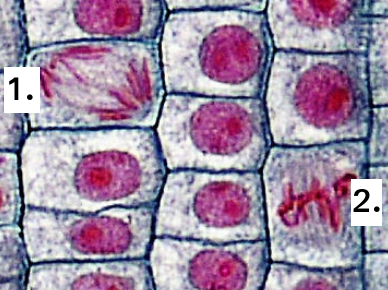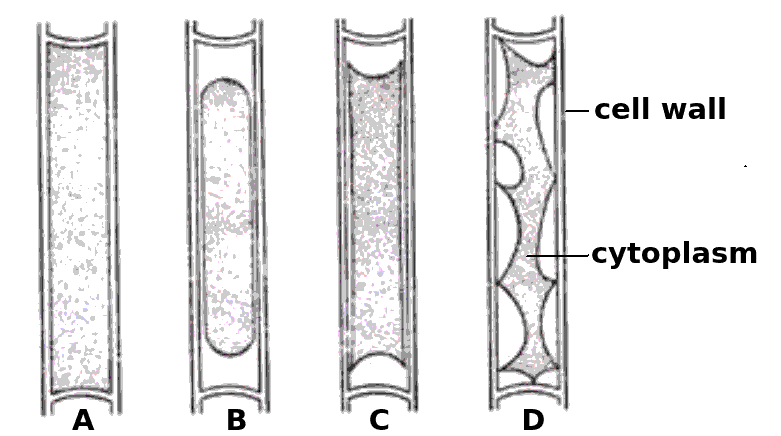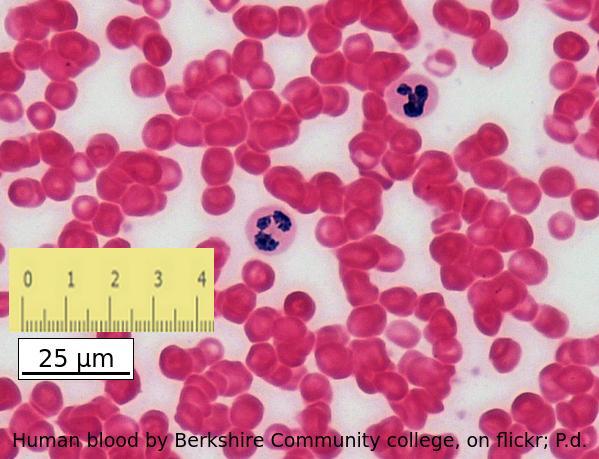Topic 1: Cell biology 
This page contains multiple choice questions in the style of Paper 1 of the Biology exams.
They test the breadth of your knowledge of the understandings and skills about cell biology.
To spend more time reviewing the topic before answering these questions, use the revision resources.
Cell biology revision resources
This page lists the understandings and skills expected for Topic 1 and links to the sub-topic pages which contain detailed revision notes, activities and past paper style questions. Great for revision.
Learn from any mistakes. Every question has an examiner's explanation that appears when you check your answers.
The image below shows two cells undergoing mitosis.

Which of the following correctly identifies the stage of mitosis for each of the cells?
Identification of the phase of mitosis is an important skill.
The position of the chromosomes gives the best clue.
In Prophase, they are spread around the cell, and double stranded.
In Metaphase, the chromosomes are lined up on the spindle equator.
In Anaphase, the chromosomes are moving to opposite poles of the cell.
In Telophase, the two groups of chromosomes are separate, sometimes with a nuclear membrane.
Which one of the statements below best describes the mitotic index?
The mitotic shows the speed of cell division, which can be used as a tool to identify cancer.
It is calculated by dividing the number of cells doing mitosis by the total number of cells.
The four cells shown below have each been surrounded by a solution for 1 hour.

Which cells have been in a hypertonic solution ?
Cell A is swollen turgid, it is in a hypotonic solution or an isotonic solution.
The cells B, C and D show increasing signs of plasmolysis, and so they must be in hypertonic solutions.
Skill: Estimation of osmolarity in tissues by bathing samples in hypotonic and hypertonic solutions. (Practical 2)
Which property of phospholipid molecules describes the fact that they have both hydrophobic and hydrophilic parts?
Phospholipids form bilayers in water due to the amphipathic properties of phospholipid molecules. The hydrophobic tails attract each other and the hydrophilic phosphates are attracted to the water.
What effect does reducing the amount of cholesterol in a cell membrane have on its properties?
Cholesterol is a component of animal cell membranes. Application: Cholesterol in mammalian membranes reduces membrane fluidity and permeability to some solutes.
The image below shows erythrocytes and leucocytes.l.

Using the scale bar and the ruler placed on the image, estimate the magnification of the image.
Which answer is the best estimate
Calculate the magnification of an electron microscope image from a scale bar?
Convert the ruler measurement to the same units written on the scale bar, in this case 25mm is 25000µm
then divide the ruler measurement 25000 by the number on the scalebar, 25.
If you know someone with a disease that might be cured by stem cell therapy then you might be a supporter of this research. You probably also know that some other people have deep concerns.
Which of the following is not a potential benefit of the use of stem cells?
There are ethical concerns about the use of embryo stem cells.
The research is expensive, and potential treatments are also likely to be expensive, and probably not available to all.
Many people who are against stem cells say that it is because cells are taken from human embryos, which have the potential for human live, and should be protected. There are other sources of stem cells, they argue.
Cells are often stored in isotonic conditions because they can be damaged in other concentrations, hypertonic, or hypotonic. Which of the descriptions of hypertonic is the most accurate?
Hypertonic solutions have a higher concentration of solutes, and lower water potentials than cells.
Which is the best definition of a tissue?
Comment:Tissues may have one or several cell types and one or more functions
Which of the following could be used to distinguish a living from a non- living object
Comment: Inanimate objects can move, produce and utilise energy but the process of respiration is exclusive to living systems
Human red blood cells are circular and 0.6 μm in diameter. A photograph of a red blood cell is shown as an illustration in a book with a diameter of 1.2mm. What is the magnification of the diagram?
Comment: Convert 1.2 mm into μm by multiplying x 1000 = 1200 μm (so that both units are the same). Then you can see that 0.6 x 2000 = 1200. Or use the formula Magnification = Image size/true size. If the photograph is larger than the cell, the magnification could not be 0.5x which would make it smaller. Eliminate obviously incorrect answers.
The image below is of Dracaena leaf upper epidermis cells.
Which of the following is the best estimate of the length (from top to bottom) of an epidermal cell?
Comment: The cells are approximately the same size as the scale bar.
This would make 70µm the closest estimate.
Which of the following are methods by which molecules can move across membranes?
I. Simple diffusion
II. Facilitated diffusion
III. Cytokinesis
IV. Active transport
There are actually four types of membrane transport which are required in DP Biology, Simple diffusion, facilitated diffusion, osmosis and active transport.
The diagram shows a typical eukaryotic plant cell. Which organelles are involved in supporting the cell and plant? I Cell wall II Cytoplasm III Nucleus IV Vacuole.

The cell and plant are supported by the turgor pressure of water in the vacuole acting on the rigid cell wall.
Which organelle in a eukarytotic animal cell synthesises proteins for exocytosis?

The RER synthesises proteins for exocytosis.
Which organelle is visible in an electron microscope but not in a light microscope?

The ribosome is too small to be seen in the electron microscope, the other organelles were seen in the light microscope before the electron microscope was invented.
The image shows a transverse section of a plant cell seen using an electron microscope.
What is the main function of the large organelle (A) seen in the cell?

The organelle shown is the nucleus, it stores the genetic information, DNA and is the location of DNA replication and Transcription.
Identify the stage of mitosis of cells 1 and 2

In cell 2, the chromatids are aligned on the equator (seen from above)- Metaphase. In cell 1, the chromatids are moving towards the poles - Anaphase.
Which property of stem cells is important for embryonic development?
Stem cells can divide and differentiate along different pathways. For a single fertilised egg cell to grow into an embryo both these processes are necessary.
A tissue is placed in an isotonic solution. Which of the following is the best description of water movement between the tissue and the solution?
There is no net water movement, gain and loss from the tissue is equal in both directions.
Refresh this page to try a new set of 20 multiple choice questions. The questions will be different next time you visit. Great revision.

 Twitter
Twitter  Facebook
Facebook  LinkedIn
LinkedIn